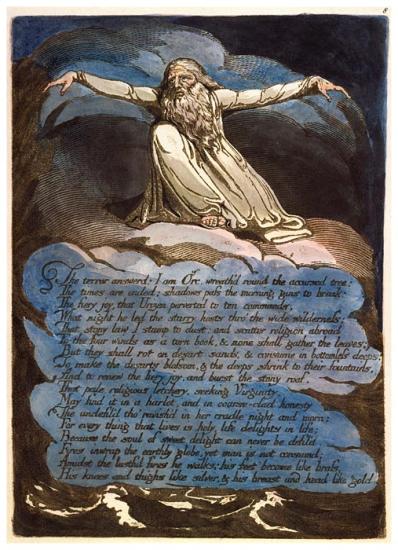
America: A Prophecy
Lambeth: Printed by William Blake, 1793
Relief etchings with hand coloring and white line etching
Copy A, printed ca. 1795
Purchased by Pierpont Morgan, 1909
William Blake (1757–1827) occupies a unique place in the history of Western art. His creativity included both the visual and literary arts. In his lifetime he was best known as an engraver; now he is also recognized for his innovative poetry, printmaking, and painting. Blake's keen perception of the political and social climate found expression throughout his work. His strong sense of independence is evident in the complex mythology that he constructed in response to the age of revolution.
Blake was already recognized as an engraver at age twenty-five, when his first volume of poems appeared. At thirty-three, in The Marriage of Heaven and Hell, he audaciously claimed that his birth had marked the origin of a "new heaven" in which his own art would exemplify the creativity prefigured by Milton and Michelangelo. By that time, Blake, in one of his most productive periods, had already produced Songs of Innocence and was at work on a series of illuminated books. In 1818 he met John Linnell, a young painter and engraver, through whom a group of young artists became Blake's followers. Calling themselves the Ancients, they helped perpetuate Blake's influence for generations.
The Morgan's Blake collection—one of this country's most distinguished—began with purchases as early as 1899 by Pierpont Morgan. During the tenure of Charles Ryskamp, director from 1969 to 1986, major gifts almost doubled the size of its Blake holdings. In recent years Ryskamp's own gifts of engravings, letters, and related materials have significantly enriched its scholarly resources.
IV. The Continental Prophecies
In 1790, Blake moved to Lambeth, where he produced a trilogy of illuminated books called the Continental Prophecies that addressed the politically charged spirit of his age, embodied by the American and French revolutions. Along with Europe and The Song of Los, America depicts the oppression exercised by monarchies and religions represented by Urizen. Although godlike in appearance, Urizen is a legalistic, despotic figure.
Another central figure is Orc, representing the spirit of revolt, who is frequently associated with images of fire. The frontispiece represents the destruction of war, while the text refers to George Washington, Thomas Paine, and other contemporary figures. America exists in only fourteen copies, five of which were colored and printed during Blake's lifetime. The Morgan also owns an uncolored copy.
This online exhibition is presented in conjunction with the exhibition William Blake's World: "A New Heaven Is Begun" on view September 11, 2009, through January 3, 2010.
This exhibition is made possible through the generosity of Fay and Geoffrey Elliott.
